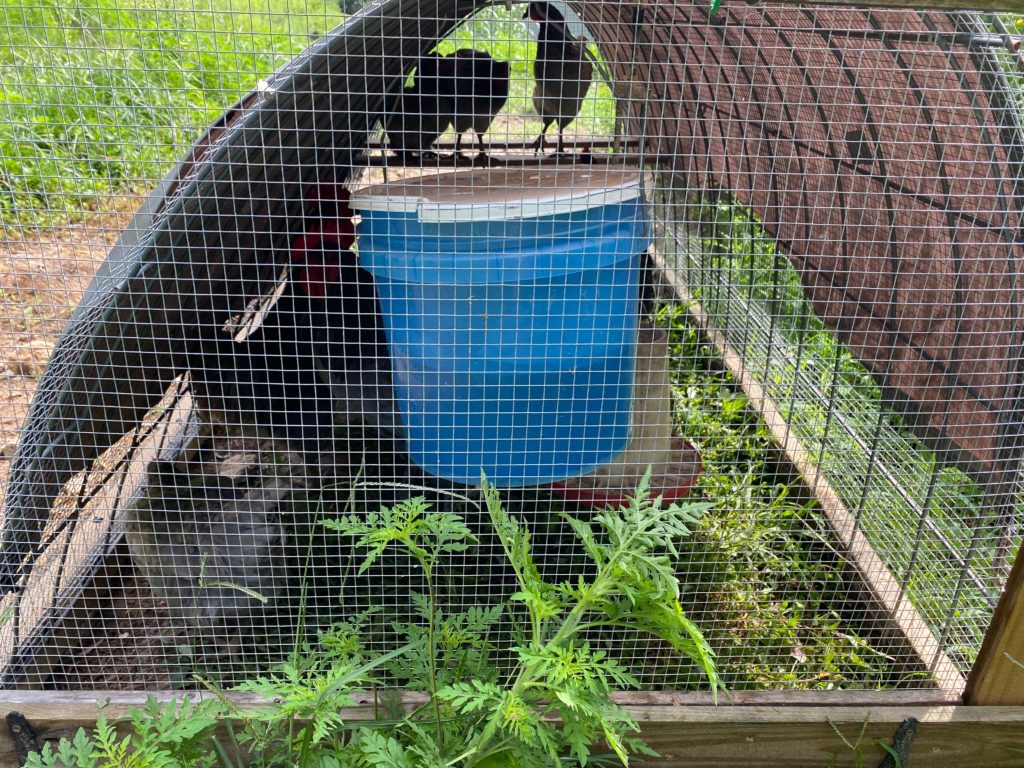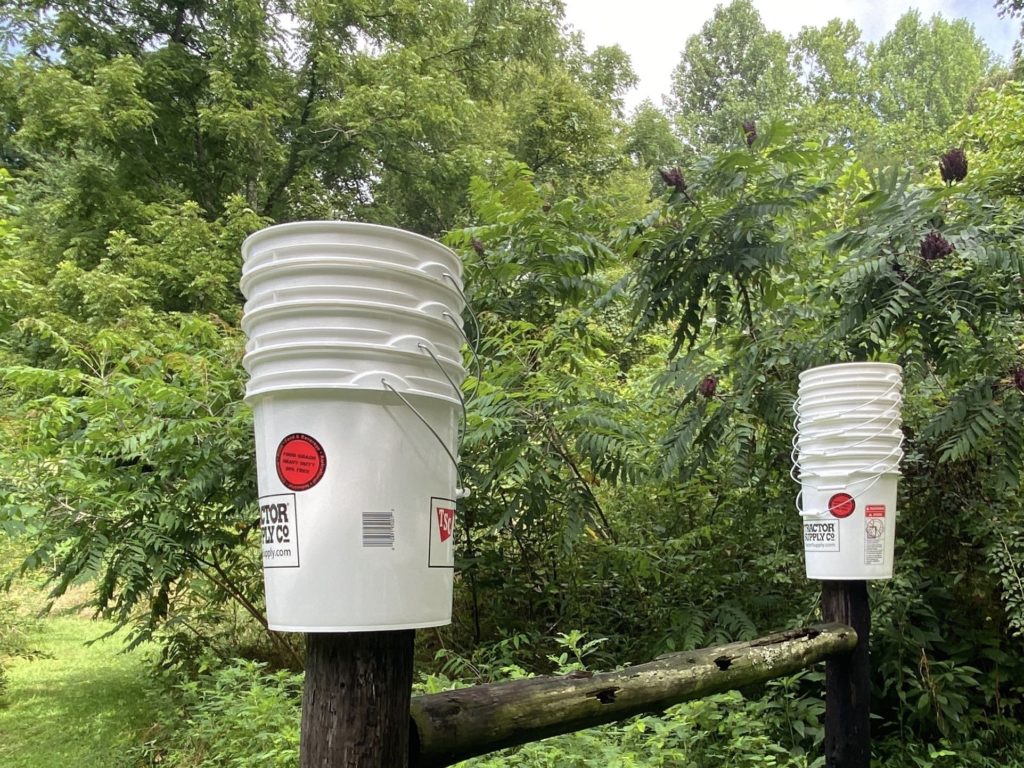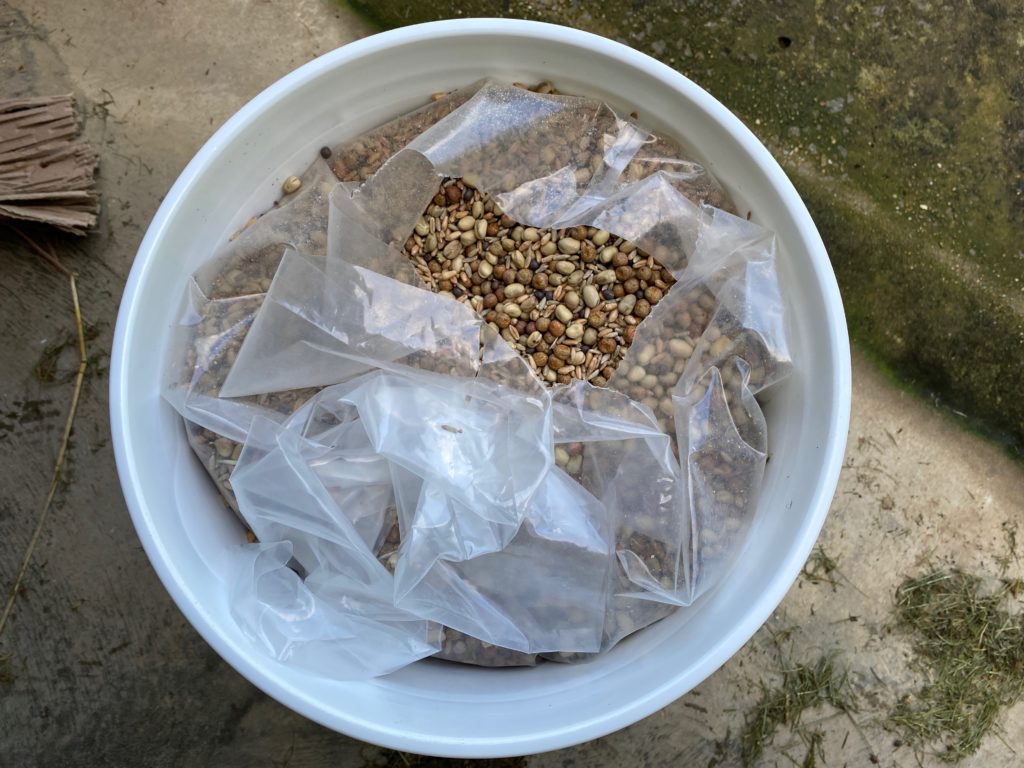If you’re a seasoned prepper, you likely already have stockpiles of certain things: food, water, ammunition, medical supplies, etc. We’ve linked to the guides for each category, but you can also take a look at the Emergency preparedness checklist: Prepping for beginners if you’re just looking to get started.
In this post, I’d like to direct your attention to an invaluable, yet easy to overlook prep: 5-gallon buckets. They’re cheap and incredibly useful.
I’ve purchased 15 (yes, that’s fifteen) 5-gallon buckets with lids since we began our COVID-19 lockdown in early March. I originally bought five during a Tractor Supply run and thought I was being a bit silly, but I soon found uses for all five and needed more!
My family uses buckets for gardening, water, food, and tool storage, but we also have plans to use buckets in an emergency situation. In this post, I’ll talk through ten solid uses for buckets and convince you that you can never have too many.
Which bucket to buy?
There are all sorts of buckets on the market, and they’re all useful, but I want to focus specifically on a certain type: 5-gallon food-safe buckets with lids. Let’s break down why each of these features is important:
- 5 gallon: A 5-gallon bucket is a generous size, but more importantly, many manufacturers make accessories that specifically fit 5-gallon buckets, which we’ll cover below.
- Food-safe: For many of the applications I’ll recommend, you don’t need food-safe buckets, but they’re not much more expensive than non-food-safe buckets, so why not spend a few extra pennies to have buckets on hand that are safe for food and water storage? We want to be flexible in our preps, and keep our options open.
- Lids: You usually have to buy lids separately, and I recommend it for each bucket you buy. Again, it’s about being flexible. You may never use the lid, but if you decide to store water in the bucket, a lid will prevent contamination and water sloshing out. If you decide to store food or seeds in the bucket, the lid will keep mice out.
I don’t have specific recommendations on buckets other than these criteria, but I usually buy the white buckets and lids from Tractor Supply. The buckets cost $3.49 and the lids run $1.99, so it’s $5.48 per bucket before tax.
Unfortunately, the large size of 5-gallon buckets makes them kind of expensive to ship, so your best bet is to take advantage of delivery or curbside service at a local store. However, you can buy a set of six food-safe buckets with lids from Amazon for $60 if those aren’t options, but you’re going to pay twice as much per bucket. The good news is if you keep your buckets out of direct sunlight, they’ll last a really long time. They’re still pretty cheap in the long run, even from Amazon.
In the garden: buckets for soil, compost, and even plants
My number one use of buckets is in my garden. I use a bucket to distribute compost and other soil amendments and gather rocks. The advantage of the bucket over a wheelbarrow is I can easily carry it in tight spots, like between rows of corn.
I keep finding uses for buckets in the garden. I recently purchased 50 pounds of cover crop seed and didn’t know how to store it. The seed is composed of peas, mustard seed, grains, and other things I’m sure rodents would find delectable. Then I remembered that I had some spare buckets! I dumped the seed into a bucket and affixed a lid. Problem solved!
There are actually infinite uses for buckets in the garden — take, for instance, growing.
My mother recently gave me some peach pits and I decided to attempt growing peach trees from them. Right now they’re germinating in my refrigerator. In a few months, they’ll be ready for a proper container, but will be too fragile to plant directly in the ground, where the elements and deer can destroy them. So I’ll put some garden soil in a few buckets and let my peach trees grow there until they’re big enough to put in the ground.
There are a number of small crops you could grow in buckets. One suggestion I’ve seen on other prepping sites is to grow potatoes in 5-gallon buckets. That’s doable, but I don’t think a 5-gallon bucket is large enough for a satisfactory harvest. For potatoes, I’d recommend a much-larger container like a garbage can.
Buckets work for drinking water
If you don’t already have water stored around the home, buckets could be key to water management in a survival situation. If the water tap stops running, you can haul water the old-fashioned way, assuming you have a local source that is reasonably clean. If all else fails, you could direct a rain gutter to flow into a bucket while it’s raining.
In the here and now, if you need to store water, a food-safe 5-gallon bucket will do the job. We recommend a number of purpose-built water storage solutions that are easier to use and store, but a bucket works too.
You can even use a bucket to filter your water. As I pointed out in my review of the St. Paul Mercantile water filters, you could substitute the stainless steel containers for plastic buckets, and many people have done so. All you need are a couple of buckets with lids, a drill, the water filter(s), and a spigot. If you don’t have the space to set up a big water filter like a Big Berkey, you could put all of that stuff together in storage and have it on hand in case you need it.
There are also purpose-built bucket filters. I recently reviewed the Sawyer Point ZeroTwo bucket filtration system. Unfortunately, Sawyer has pulled that product from sale in the United States due to supply chain issues so that they can focus the existing supply on countries with more severe water issues.
More: Best home water filter
Stacks of buckets in the pantry
Lidded buckets can also be used for storing food. This can be as simple as tossing in bags of beans and rice in a bucket to keep mice from chewing into the bags.
If you want to set up more long-term food storage, a popular method is to put the food in mylar bags, throw in an oxygen absorber (Unless you’re storing sugar! Oxygen absorbers will turn sugar into a brick.), and seal the bag with a clothes iron or hair straightening iron. You can buy these mylar bags in a variety of sizes, including ones designed to fit in a 5-gallon bucket. Based on my research, you want at least 5 mil-thick bags.
I’ve purchased some mylar bags, so I’ll be experimenting with this method soon.
Buckets make for better toolboxes
A few years ago, I bought this Wirecutter-recommended Milwaukee toolbox. I hate it. It is a glorified bucket.
What I should have bought instead is a real bucket and a Bucket Boss tool organizer. The Bucket Boss fits into a 5-gallon bucket, providing a number of pockets on the inside and outside. You can toss tough items like hammers into the bucket and keep more delicate items like chisels in the outer pockets.
One of the selling points of the Milwaukee toolbox is that the lid is tough enough to use as a seat. Bucket Boss has a solution for that too, and the seat doubles as a small parts organizer.
More: Review: Chillington Pointed Garden Hoe by Easy Digging
Chicken care and feeding
I use a lot of buckets in caring for my chickens. I use a Hen Hydrator in my chicken tractors, but in reality, the hydrater is just a glorified bucket with watering nipples. You can buy said nipples in a 50-pack for under $20. The chickens peck at the nipples to get water.

Installing the nipples (stop giggling) is easy: just drill a few holes in the bottom of a bucket with an 11/32” bit and screw the nipples in. You might also need some vent holes in the lid to ensure reliable water flow. Hang the bucket up in your chicken tractor or chicken run, and the chickens will soon figure out how it works.
That’s just one chicken-tending use for buckets. Some people use them as chicken feeders and nesting boxes.
And when it’s time to process your chickens, the buckets are handy for holding and hauling away chicken guts.
More: COVID-19 food shortages: get a CSA membership, or maybe your own chickens
In a real pinch, a bucket becomes a toilet
Maybe not for every day, but in a true emergency, a bucket can work surprisingly well as a toilet.
Once, I was foolish enough to work on our then-only toilet during Memorial Day weekend. I overtightened a bolt and cracked the porcelain tank, which is surprisingly easy to do. No longer trusting myself to work on toilets, we couldn’t get a plumber over until the following Tuesday. At the time, we lived in a suburb, so going outside was not an option. Thankfully, we had a 5-gallon bucket.
Yes, if you must, a bucket can be a fitting replacement for a toilet. You can even buy a special toilet seat to fit on a 5-gallon bucket to make the experience a bit more comfortable.
There can be some advantages to doing your business in a bucket. Diluted urine can make for a powerful fertilizer. If you’re especially brave, you can use the other stuff as fertilizer, too: check into The Humanure Handbook by Joseph Jenkins and Compost Everything: The Good Guide to Extreme Composting by David the Good.
https://www.youtube.com/watch?v=Fp1dxOmBD00
But whatever you do, don’t mix up your toilet bucket with your water bucket!
Fishing
Buckets have obvious uses for fishing, such as storing bait and hauling your catch home. But there are a number of add-on products made specifically for fishing, such as this Wild River bucket organizer (the bucket is included), this lid to turn your bucket into a proper bait bucket, and this lure holder.
I have no experience with these products (and I’m a lousy fisherman), but I’m pointing these out to demonstrate what some of your options are.
A pack for chores and gardening
While researching this article, I came across this gizmo that adds backpack straps to a bucket, turning it into a pack basket. I have never tried this, but it’s something I’m going to look into whenever my fruit trees start producing.
Homebrew
I don’t advocate drinking alcohol, but I can’t deny that brewing and possibly distilling it can have great value in a survival situation. Have a lot of fruit that’s going to go bad and no way to preserve it? Mash it in a sanitized bucket with sugar and yeast to make wine or cider. Make sure to drill a hole in the lid to accommodate an airlock. You could then distill the results to make alcohol for medicinal purposes. That’s probably very much illegal wherever you are, but if the grid is down and it truly has hit the fan, the revenuers will probably have bigger problems.
A bucket as a washing machine
While nobody wants to do their laundry in a bucket, it’s an option if you don’t have running water. There’s a tool to help with this, a tin-plated steel plunger called the Rapid Washer, but unfortunately, it’s out of stock everywhere. However, there are plastic variants of the clothes-washing plunger available, like the Breathing Mobile Washer Classic.
But you don’t have to buy any special tools. A YouTube tutorial can teach you how to wash your clothes with a 5-gallon bucket, a regular plunger, and a drill. Just drill a few holes in the plunger to improve water flow, drill a hole in the center of the bucket lid to accommodate the handle, and you can plunge your clothes to cleanliness just as you’d churn butter.
One commenter mentioned using a plastic handle instead of wood because the wood can wear off the plastic in the bucket. Another mentioned using a long broom handle to avoid stooping down, so you might also want to buy a long plastic broom handle to attach to the plunger to make things easier on yourself.
It’s all about versatility
Some of these uses for buckets might seem silly, but the point is that buckets are incredibly useful and versatile for prepping. As far as I’m concerned, you can’t have enough buckets. Whether it’s hauling compost, storing food, or filtering water, buckets have become an essential part of our household during the COVID-19 pandemic. What other common, multipurpose household items do you stock up on? And if you’ve found other interesting uses for buckets, let us know.


You are reporting the comment """ by on